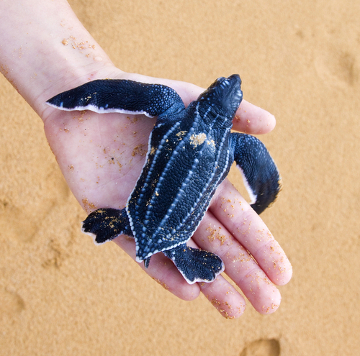THE leather turtle, also called giant tortoise, is a species of reptile marine that has the scientific name of Dermochelys coriacea. This species is the largest known and can reach, on average, up to 700kg and reach two meters in length. The largest individual ever found had a carapace length of 2.56 meters.
This species of turtle is found in tropical and temperate oceans around the world. In Brazil, it often spawns on the coast of Espírito Santo, but sometimes this spawning is observed in areas of Rio Grande do Norte, Bahia, Piauí, Rio de Janeiro, Santa Catarina and Rio Grande do South.
The leatherback has a carapace formed by a resistant skin and several small bony plates. It also has seven fins distributed along the length of the carapace. Its color is black with several black and bluish spots.
Your food is based on gelatinous organisms, mainly cnidarians, such as jellyfish and jellyfish. They feed both in shallow areas and at great depths, and can be found at depths of up to 100 meters.
Your reproduction it takes place between September and January and every two or three years. In each breeding season, this species can perform between five to seven spawns, being deposited in each spawning about 80 viable eggs and 20 non-viable eggs.
The sex of turtles is influenced by temperature, so global warming has a direct influence on these animals. Puppies, when they are born, are easily preyed upon by mammals, birds, fish and molluscs, like the squid. Larger individuals are usually killed by large animals such as whales and sharks.

Leatherback turtles, when small, are preyed upon by mammals, birds, fish and molluscs.
The leatherback turtle is considered critically endangered on the Red List of the IUCN (International Union for the Conservation of Nature and Natural Resources). Factors such as pollution and accidental fishing strongly influence the reduction of individuals of this species. Furthermore, as they feed on jellyfish, these turtles often confuse plastic bags with their food and, consequently, die from ingesting this material.
Heads up: If you don't know it yet, it's worth visiting the site and personally meet the Tamar project, a project that aims to research and conserve the species of sea turtles existing in our country. There are eleven visitor centers spread along the coast of Brazil.
By Ma. Vanessa dos Santos



